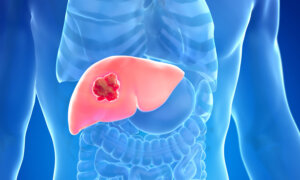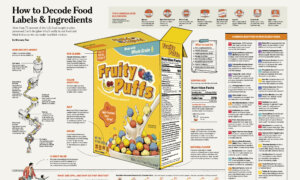While battling an obstinate belly bulge and seeking to reclaim a flat tummy, South African health coaching student Georgina Djan stumbled upon an unconventional strategy that not only reshaped her body but also transformed her energy levels and outlook on life.
Her secret? Rethinking the order in which she consumed her meals.
“I had never struggled with my weight, even after having four children,” Ms. Djan told The Epoch Times. But when her youngest was diagnosed with an autoimmune disease, she turned to comfort eating, which led to weight gain around her midsection that seemed impossible to shed.
That was until she read about the significance of meal sequencing, which involved starting with vegetables, following with proteins and fats, and finishing with carbohydrates. Adhering to this eating pattern, Ms. Djan said she saw “significant changes.”
Why Protein Before Carbs?
This personal experience aligns with scientific evidence.
Unlike established dietary advice emphasizing portion control and what to avoid, a study published in Diabetes Care highlighted the importance of timing carbohydrate consumption. Compared with consuming carbohydrates first, post-meal blood sugar levels decreased by up to 36.7 percent when vegetables and protein preceded carbohydrates.
A 2019 study in the Journal of Diabetes and its Complications found that people lost more weight when they focused on meal sequence instead of following standard guidance.
Adjusting meal order is a simple method for preventing Type 2 diabetes and obesity, according to a 2020 scientific review published in Nutrients. Consuming protein or fat before carbohydrates promotes glucagon-like peptide-1 (GLP-1) secretion, enhancing insulin secretion, inhibiting glucagon release, delaying gastric emptying, and improving blood sugar fluctuations. (GLP-1 suppresses appetite, contributing to weight loss.)
A Diabetes Care study demonstrated that administering whey protein before or with a high-carbohydrate meal significantly reduced blood sugar levels in Type 2 diabetes patients, comparable to pharmacological therapies such as sulfonylureas, a class of oral diabetes medications. The authors suggested that nutritional strategies such as these may hold potential for diabetes management.
Starchy carbohydrates are quickly digested and absorbed when consumed alone or first, while proteins undergo initial stomach digestion, delaying subsequent carbohydrate absorption and moderating glucose release into the bloodstream, Nicky Denvir, a UK-based nutritional therapist, told The Epoch Times.
Why Veggies Before Carbs?
Unlike protein and fat, consuming dietary fiber before carbohydrates may not enhance GLP-1 secretion but still reduces postmeal blood sugar spikes, potentially aiding weight loss. According to the Nutrients review, combining fiber, protein, and fats before carbohydrates benefits metabolic conditions such as obesity and diabetes.
A Japanese study, published in the Asia Pacific Journal of Clinical Nutrition, involving Type 2 diabetics found that eating vegetables before carbohydrates is more effective for blood sugar balance than an exchange-based meal plan detailing portion sizes and nutrient content. Over two years, participants following this approach achieved better glycemic control, measured by changes in HbA1c, a blood test that measures average blood sugar levels over a couple of months.
People with diabetes who followed the vegetables-before-carbohydrates (VBC) method also required fewer calories despite the study’s lack of a calorie-restriction focus. Participants found VBC easy to understand and sustain, contrary to beliefs that rigid control is necessary for diabetes management.
Consuming vegetables first slowed carbohydrate digestion, requiring less insulin.
Soluble fibers such as psyllium husk help blood sugar regulation by delaying gastric emptying and forming a gel matrix in the small intestine, hindering enzyme access to carbohydrates and slowing glucose release, Ms. Denvir said. Studies have shown significant glucose reductions with 5 grams to 15 grams (0.2 ounces to 0.5 ounces) of psyllium before carbohydrate-rich meals, she said.
Meal Sequencing for Sustained Energy
Adjusting the order in which we eat can help maintain steady blood sugar levels, which prevents energy dips and keeps us fueled throughout the day, Mary Curristin, a nutritionist from ART Health Solutions, told The Epoch Times.
A well-balanced diet rich in essential nutrients and fiber can significantly enhance mood stability and productivity by supporting optimal brain function and maintaining consistent energy levels, she said.
Ms. Djan said that while she was visiting her son in Johannesburg, her friends noticed her slimmed-down appearance, as her once-protruding tummy had noticeably flattened. But the benefits extend beyond the physical, she said.
“I also found myself waking up energized and feeling more positive about life,” Ms. Djan said.
How to Follow the Food Sequencing Strategy
Prioritize consuming vegetables and proteins before carbohydrates in each meal. For instance, if you’re having pasta or a sandwich for lunch, start with a salad and some turkey.
Some studies have found that slowing down while eating and waiting a few minutes before having carbohydrates might be beneficial. Authors of the Japanese study recommend chewing each vegetable bite thoroughly, more than 20 times, to slow your eating pace. The Journal of Diabetes and its Complications study with prediabetic subjects had participants eat vegetables and proteins during the first five minutes of their meal, then wait five minutes before consuming carbohydrates to improve glycemia.
However, a 2023 study published in Nutrients found no significant difference in blood sugar levels after a meal between fast and slow eaters, as long as vegetables were consumed first. These findings suggest that the order of food intake—vegetables first and carbohydrates last—improves blood sugar levels and insulin concentrations, even if the meal is eaten quickly.














